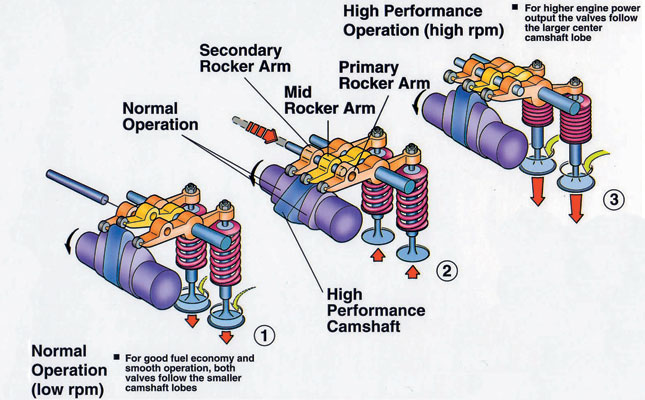Many modern engines employ variable valve timing to create a range of throttle opening/engine speed combinations where the air mass flow is very high.
This increases average breathing efficiency and torque output, and reduces fuel consumption.
With fixed intake valve timing, the norm until a few years ago, there is only one throttle opening/ engine speed combination where the optimal volume of air reaches the combustion chamber. This is when the manifold air speed is between 90m/s and 110m/s.
Above and below these values, the inhaled volume of air is less, the amount of fuel injected is less, and the torque is less.
In fact, a curve of air speed against engine speed is shaped like the torque/engine speed curve.
Exhaust valves
Exhaust valve timing vis-à-vis engine speed also plays a role. The easier it is for the exhaust gas to leave the combustion chamber, the lower the pressure above the pistons will be on the next intake stroke, and the more air will be sucked in.
Engine speed where maximum torque is delivered can be controlled by arranging the intake and exhaust timing so that valve timing is most favourable for maximum airflow.
Intake and exhaust valve opening and closing times, as well as lift, are all determined by the shape and positioning of the cam lobes on the camshaft.
The port and valve seat diameters can then be chosen to ensure the gas flow is ideal.
This implies that a camshaft change is all that is needed to turn a passenger car engine into a tractor engine. In practice, many engine components must be made more durable.
Slow vs fast
In low-speed stationary engines, the intake valves open when the pistons are at the top (top dead centre, or TDC), and are starting to travel down on the intake stroke.
These valves close at bottom dead centre (BDC) at the start of the power stroke. Exhaust valves have similar valve timing.
In engines that go much faster, this timing does not work. Air takes time to start moving, so that as the engine speeds up, this valve opening setting reduces the time available to fill the space above the pistons.
For example, 1 200 rp m is equivalent to 1 200/60 = 20 revs/ second, or
1/20 = 0,05 seconds per revolution.
If the speed is doubled to 2 400 rp m, the time reduces to 0,025 seconds. At 6 000 rpm, each revolution is completed in 0,01 second or 10 milliseconds.
This problem is solved by increasing the time the valves stay open. A typical engine will open the intake valves at 10° before TDC, that is, while the piston is going up on an exhaust stroke, and close them at 50° after BDC on the compression stroke.
At low speed, this forces some air back into the intake manifold, but there will be a speed in the 2 000 rpm to 4 000 rp m range where the air mass entering an engine, and hence the torque, is at a maximum.
Variable valve timing, by means of bringing alternative cam lobes into action, or changing the crankshaft/camshaft relationship with respect to each other, is found on many engines.
Jake Venter is a journalist and a retired engineer and mathematician. Email him at dhumirawellington@gmail.com



